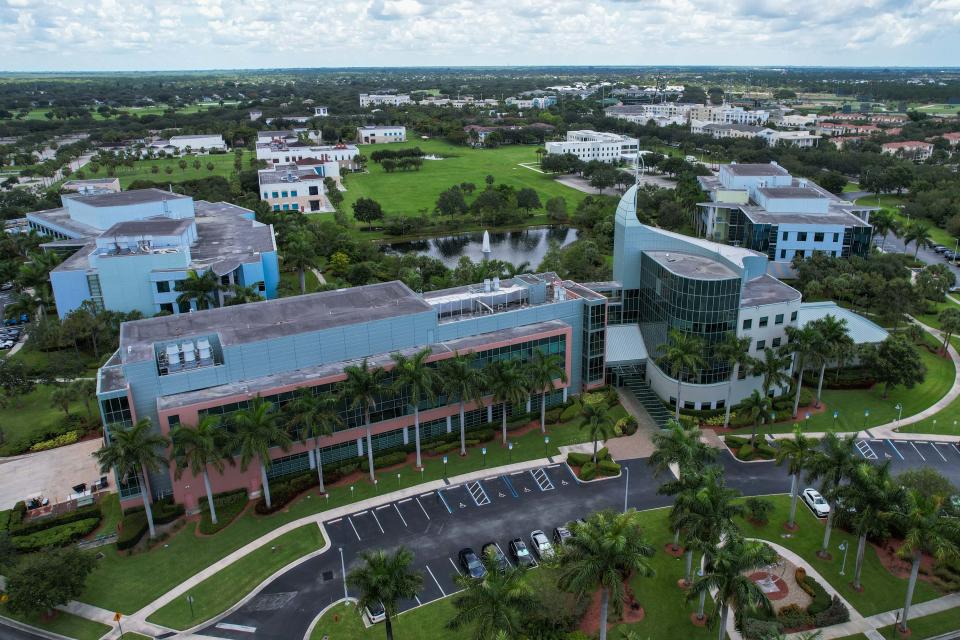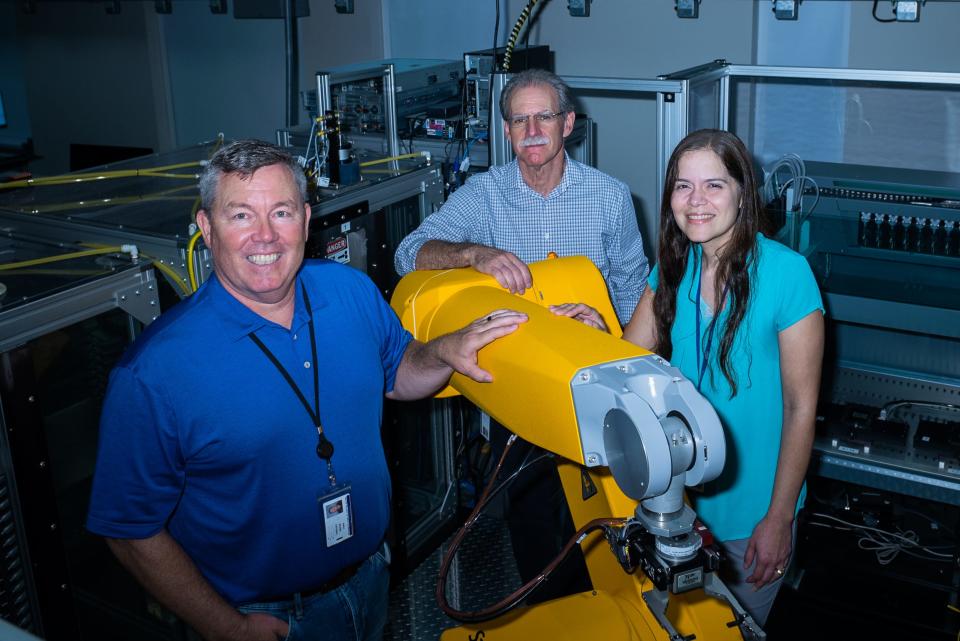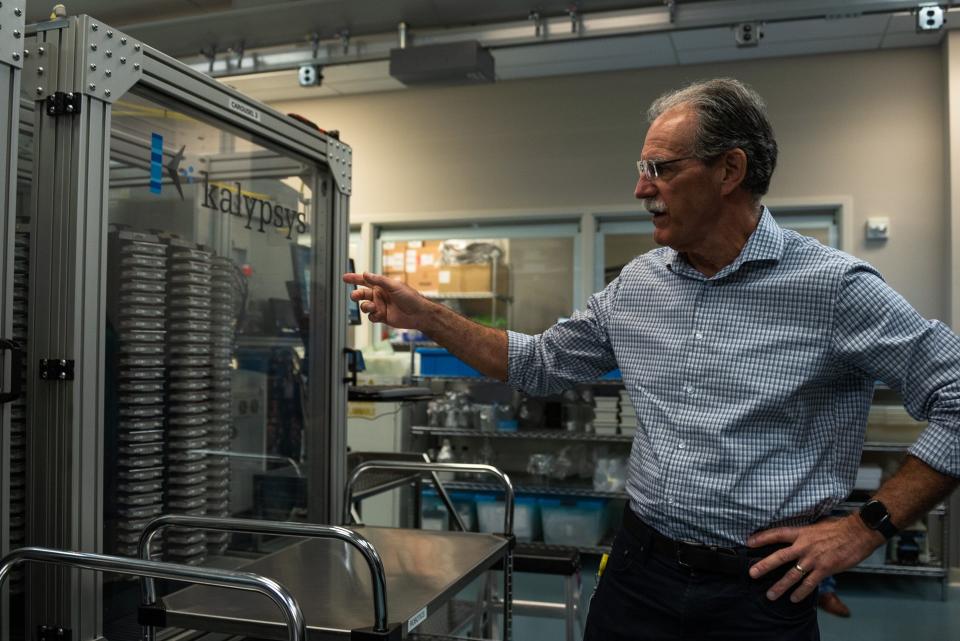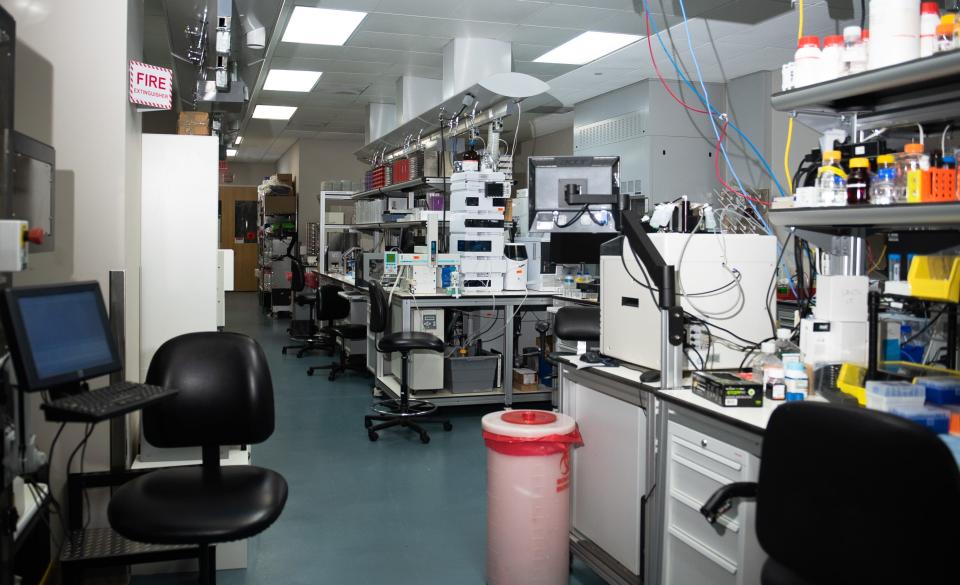How do you attack brain cancer? A world-class lab in Jupiter is trying something innovative.
- Oops!Something went wrong.Please try again later.
JUPITER — Groundbreaking work to revolutionize treatment of a dangerous form of brain cancer using new technology including robotics is among the innovative research taking place at a lab in Jupiter.
A team at The Herbert Wertheim UF Scripps Institute for Biomedical Innovation and Technology is working with researchers at the Marcus Neuroscience Institute at Baptist Health Boca Raton Regional Hospital on the project, which targets potential treatments for glioblastoma, an aggressive cancer with just a 5% five-year survival rate for people age 45 or older.
The team’s work to identify the most-effective therapies to treat a particular tumor uses a combination of state-of-the-art robotics and sample screening technologies to quickly and precisely test how dozens of drugs would affect a specific patient’s glioblastoma, said Timothy Spicer, a senior scientific director in Wertheim UF Scripps' Department Of Molecular Medicine.
It’s one of many projects happening at the research facility, which last year became part of the University of Florida. The acquisition by UF included the research institution’s three buildings, staff, equipment and other assets, including 70 acres in Palm Beach Gardens.
Suni Sands dispute: Jupiter OKs dig over cries of 'Shame!' from those who want historic site preserved

The acquisition by UF was followed in October of last year by a $100 million gift to the institute from the Dr. Herbert and Nicole Wertheim Family Foundation.
In the year since, the partnership between UF and Scripps has been a match made in heaven for the school, the institute and the research being done there, said Stacey DeLoye, Wertheim UF Scripps’ director of communications.
“Normal universities don’t have drug discovery machinery and expertise like this,” she said.
That revolutionary combination of machinery and expertise was recognized in June when the UF Health Cancer Center — including the Jupiter research facility — received the National Cancer Institute designation, opening the door for more grant money and partnerships.
Here’s a look at three incredible research programs underway right now.
Jupiter U.S. 1 bridge replacement: New channel gives boaters relief, safe passage
What drugs are effective? Researchers getting faster answers
The collaborative work being done between The Wertheim UF Scripps Institute and Boca Regional, along with partners at four other institutions, is helping researchers identify potentially effective drugs faster than ever before.
Patients at Boca Regional who are diagnosed with glioblastoma are informed of the program and must consent to participate. Once a patient consents, samples of their tumor are sent directly to Jupiter, where the research team immediately gets to work.
“That call could come at any time,” said Virneliz Fernandez-Vega, a Wertheim UF Scripps scientific associate. “They send it right away. We have to stop everything.”

Fernandez-Vega carefully extracts minute samples of the tumor that are then put into a machine that tests them against nearly every known cancer-treatment drug — at least 128, Spicer said.
“We look at the drug’s effects, either in combination or by itself,” he said.
The technology has helped the team narrow the discovery window to about six weeks to culture and grow the samples. That’s enough time for the patient to undergo an initial round of chemotherapy and high-dose radiation, Spicer said.
'Never seen before': Sea turtles likely to break nesting records on Jupiter-area beaches
Could this mean a better prognosis for people diagnosed with glioblastoma?
“If we work fast enough, between initial resection and when they come back — and they invariably come back,” he said.
This could be the key to achieving “lab-to-bedside” treatment that is targeted and efficient in treating certain kinds of cancer, said Louis Scampavia, Spicer’s fellow senior scientific director in the Department Of Molecular Medicine.
“It’s satisfying,” Fernandez-Vega said. “Being able to get so close to clinical, it’s definitely a whole different spectrum.”

Through their research, the team members have not only found a faster way to find more efficient treatments for glioblastoma, they have also created new methods to do so.
The researchers developed a new kind of sample tray that includes dozens of wells to test as many types and combinations of cancer-treatment drugs as possible.
They’ve also revolutionized the use of robotics.
In a large room on the first floor of the Jupiter campus’ north building, researchers perform what is known as High-Throughput Molecular Screening — quick review of samples done with the aid of a robotic arm.
Jupiter's new $24.7 million town hall: A look at how the construction is going and the timeline
The bright yellow Stäubli Robotic Arm moved quickly on a recent day as it worked on its programmed task of dropping measured amounts of cancer-treatment drugs into the tiny wells of a sample tray.
It’s a tool the researchers have used across a number of projects — including one that could change the way future pandemics are handled.
In addition to the work being done to detect the most efficient treatments for glioblastoma, another research project at Wertheim UF Scripps recently found that the cancer may be able to use two mutations to hide tumors from the body’s immune system.
This could open the door for doctors to use a new class of immunotherapy drugs to treat glioblastoma, the researchers said.
How do you kill the next pandemic virus? Research already underway

Following the advent and peak of the COVID-19 pandemic, the National Institutes of Health made it a priority to be better prepared should another pandemic occur.
That prompted research that is now being done at research facilities around the country, including The Wertheim UF Scripps Institute in Jupiter.
“This is helping us to create the next generation of pandemic-preventing drugs or rescue drugs,” Scampavia said.
Last year, the institute announced it had received grants from the National Institute of Allergy and Infectious Disease that could total more than $15 million in the next three to five years.
As part of the grants received by the institute, the High-Throughput Molecular Screening team will use the robotic arm to help them screen every compound in Wertheim UF Scripps' vast collection to see which would be most effective to kill a virus.
“This is the epicenter of our nation’s preparedness efforts against the next pandemic,” Scampavia said.
“The future for us is bringing in more and more samples,” Spicer said. “We want to be able to push out answers every day.”
This article originally appeared on Palm Beach Post: Wertheim UF Scripps Institute in Jupiter uses tech to target brain cancer

